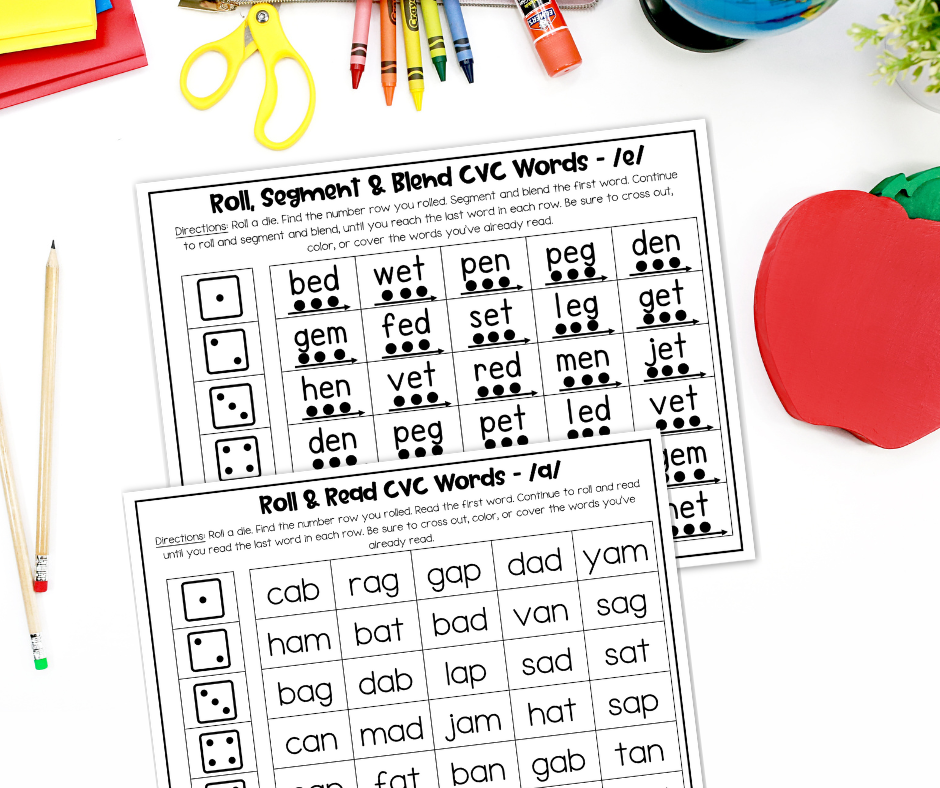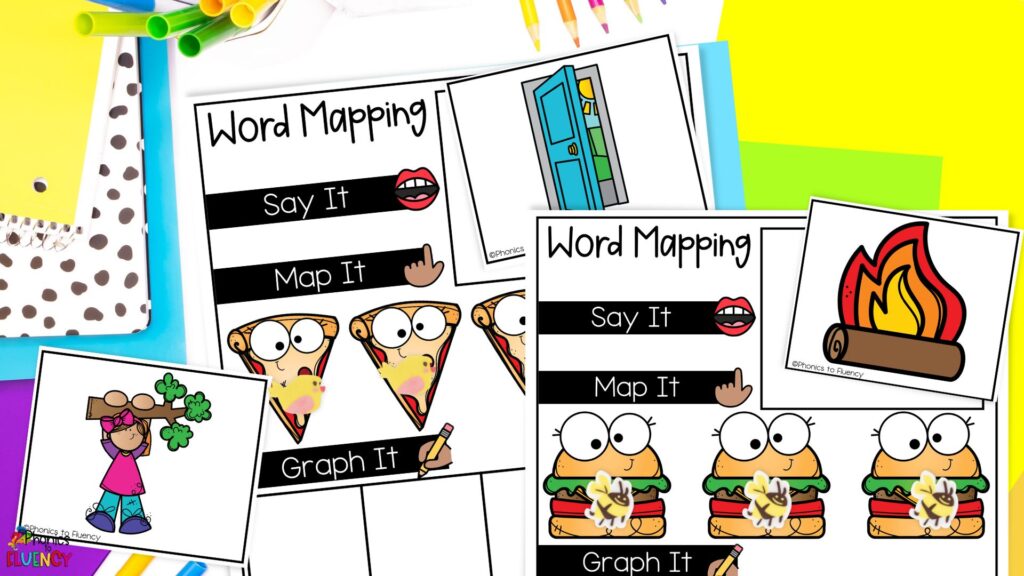
Teaching students how to read is one of the most rewarding parts of teaching kindergarten. However, it can also be incredibly challenging! One of the fundamental concepts students have to learn is how to read a CVC words list. Not sure how to tackle that big list? Keep reading and I’ll explain why those CVC words for kindergarten are important as well as how we can teach them effectively to our little learners.
A CVC word is a three-letter that has a pattern: consonant-vowel-consonant. Some CVC words include cat, dog, sit, hat, and run. These simple words are the first words kindergarteners learn to read because they follow the rules of phonics to a T. Because they follow phonics rules, they are super important to learn because they will be the catalyst to more in–depth reading later on. Not only will understanding CVC words help students read better, it will also help them with spelling and writing.
In order for kindergarteners to learn CVC words, they need to know what CVC words are. To begin, you can start by showing them actual objects that have the CVC pattern. For example, you can show them a picture of cat or bring out a real-live hat. This visual representation helps kindergartens understand the world in a real-life context which will create connections for them to relate to.
You can also use the sandwich analogy or interactive games. Because students love a good competitive edge, using them to explain CVC words can be incredibly effective. For example, you can use a CVC word matching game where students match pictures to the CVC words for kindergarteners. You can also use a “sound box” where students write the letter that is represented by that sound in each box. This will help segment and blend sounds in a way they can not only see but also have fun with.
The main reason you need to teach CVC word lists in kindergarten is to help students get familiar with the idea of phonics. Phonics is the relationship between letters and sounds which helps students develop reading skills. In addition, objects can enhance phonemic awareness which includes their ability to hear, identify, and manipulate individual sounds all while building their vocabulary.
When students are able to use phonics, they will be able to decode skills which means they can sound out words with ease. This makes processing complex words easier, creating more confidence for their future.
Because you are requiring kindergarteners to learn CVC words, they will gain confidence in their reading and writing skills and set a strong foundation for their literacy journey.

Decoding CVC words means you have to understand the sound each letter makes then blending those sounds together to create a word. Really, it’s a step-by-step process which includes:
For example, look at the word “hat.” The first step is to pull apart each letter or sound: /h/, /a/, /t/. Then, say each sound and blend them together to get /h-a-t/. By doing this, students will see words as a combination of sounds which will help with reading and spelling.
A great way to decode letters is to use magnetic letters or letters cards. These magnets or cards can separate the letters out and students can say each sound while seeing them. This visual can be a game changer for students when they are just learning how to decode words because it makes the building and blending sounds visual. You can also use tiles as another visual option.
Knowing your short vowel sounds is important when you are teaching CVC words for kindergarten. All CVC words will use short vowel sounds, not long. So, knowing the ‘a’ in ‘cat’, the ‘e’ in ‘bed’, the ‘i’ in sit’, the ‘o’ in ‘dog,’ and the ‘u’ in ‘sun,’ is incredibly important. Not only are these important for understanding CVC words, but they create phonemic awareness for more complex words in the future.
When you are teaching the short vowel sound, you can use other words to help students understand what each sound is. For example, you can talk about apples for the a sound, egg for the short e sound, igloo for the short i sound, octopus for the short o sound, and umbrella for the short u sound. Teaching these short vowel sounds is important to helping kindergarten students learn CVC word lists.
It might seem like there’s not that much of a difference between short vowel words and CVC words, but they are different. All CVC words have a short vowel sound. However, not all short vowel words are CVC words. Short vowel words can have more than three letters like ‘trap” or “spin”. However, a CVC word will always have three letters that follow the consonant-vowel-consonant pattern.
Reading CVC words is an important first step in a student’s reading journey. Knowing your CVC word lists means you are understanding phonics and can decode and encode words independently. This boosts the kindergartener’s reading ability, spelling skills, and overall confidence.
With CVC word mastery, students will start to recognize common words which will help their speed and fluency as well. All of these skills will help students be able to read sight words easier because many of the words that are CVC words also show up on sight word lists. Because of this, your kindergarten students will be able to comprehend texts better as well.
There are so many CVC words in the world. How many CVC words for kindergarteners are there? Well that really depends on your students and where they are. In a perfect world, students should be able to read around 20 to 50 CVC words. While this is ideal, you don’t need to rush the process. Make sure your students are comfortable and confident in reading the words before moving on to new ones. Some students will get it right away; however, others might need more time. So, focus on a supportive and stress-free environment where students can learn at their own pace. A great way to do that is with differentiated centers or activities.
Teaching CVC words in kindergarten is a crucial first step for young readers when they are just starting out. As teachers, we need to use patience, repetition, and creative teaching strategies like games, centers, and more to help kindergarten students master their words. By doing so, you’ll be setting your students up for reading and writing development. Plus, they’ll start to enjoy the reading process! So, make sure you start teaching your CVC word for kindergarteners right away to gear up your readers! Make learning a fun and rewarding experience and watch your students blossom!
XO, Kisha

Phonics to Fluency

It brings me so much joy creating high-quality, hands-on, research based Literacy and Math resources that are both engaging for students and save YOU time!

Let me give you some time back!
Just tell me where to send them…


I’d love to connect and get to know more about you!
Join the Phonics to Fluency community and connect, collaborate, and grow alongside other dedicated K-1 teachers and homeschool parents in our exclusive Facebook group.
© 2023 PHONICS TO FLUENCY | ALL RIGHTS RESERVED | SITE DESIGN BY AMY REIS CREATIVE
Subscribe to get a coupon code for 15% off your first purchase. PLUS receive regular updates and offers in the Phonics to Fluency newsletter,